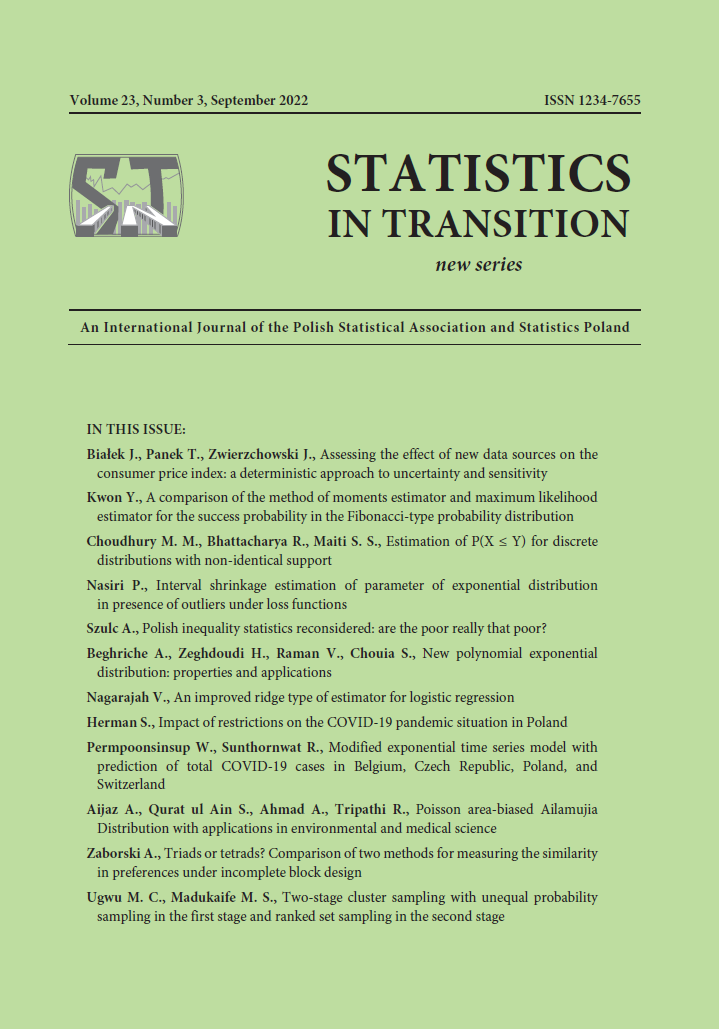ARTICLE
ABSTRACT
The coronavirus (COVID-19) pandemic affected every country worldwide. In particular, outbreaks in Belgium, the Czech Republic, Poland and Switzerland entered the second wave and was exponentially increasing between July and November, 2020. The aims of the study are: to estimate the compound growth rate, to develop a modified exponential time-series model compared with the hyperbolic time-series model, and to estimate the optimal parameters for the models based on the exponential least-squares, three selected points, partial-sums methods, and the hyperbolic least-squares for the daily COVID-19 cases in Belgium, the Czech Republic, Poland and Switzerland. The speed and spreading power of COVID-19 infections were obtained by using derivative and root-mean-squared methods, respectively. The results show that the exponential least-squares method was the most suitable for the parameter estimation. The compound growth rate of COVID-19 infection was the highest in Switzerland, and the speed and spreading power of COVID-19 infection were the highest in Poland between July and November, 2020.
KEYWORDS
COVID-19, modified exponential time-series model, method of parameter estimation, compound growth rate.
REFERENCES
Areepong, Y., Sunthornwat, R., (2021). EWMA control chart based on its first hitting time and coronavirus alert levels for monitoring symmetric COVID-19 cases. Asian Pacific Journal of Tropical Medicine, 14(8), pp. 364–374.
Argaru, A. S., (2020). Linear regression model for predictions of COVID-19 New cases and new deaths based on May/June Data in Ethiopia, Research Square, doi:10.21203/rs.3.rs-61667/v1.
Benvenuto, D., Giovanetti, M., Vassallo, L., Angeletti, S. and Ciccozzi, M., (2020). Application of the ARIMA model on the COVID-2019 epidemic dataset, Data in Brief, 29(105340), pp. 1–4.
Chaurasia, V., Pal, S., (2020). COVID-19 pandemic: ARIMA and regression modelbased worldwide death cases predictions, SN Computer Science, 1(288), pp. 1–12.
Cheng, Y., (2020). Linear regression analysis of COVID-19 outbreak and control in Henan province caused by the output population from Wuhan. medrxiv, doi: 10.1101/2020.05.03.20089193.
Das, B., Chakrabarty, D., (2017). Representation of numerical data by exponential curve. Journal of Mathematics and Systems Sciences, 13(1-2), pp. 1–6.
Ekum, M. and Ogunsanya, A., (2020). Application of Hierarchical Polynomial Regression Models to Predict Transmission of COVID-19 at Global Level. International Journal of Clinical Biostatistics and Biometrics, 6(1), pp. 1–18.
Fang, L., Wang, D. and Pan, G., (2020). Analysis and Estimation of COVID-19 Spreading in Russia Based on ARIMA Model. SN Comprehensive Clinical Medicine, doi: 10.1007/s42399-020-00555-y.
George, E. P. B., Gwilym M. J., Gregory, C. R. and Greta, M. L., (2015). Time Series Analysis: Forecasting and Control. 5th ed. Hoboken, New Jersey: John Wiley & Sons, Inc.
Ghosal, S., Sengupta, S., Majumder, M. and Sinha, B., (2020). Linear regression analysis to predict the number of deaths in India due to SARS-CoV-2 at 6 weeks from day 0 (100 cases - March 14th 2020). Diabetes & Metabolic Syndrome: Clinical Research & Reviews, 4(4), pp.311–315.
Hoseinpour, D. A., Alizadeh, M., Derakhshan, P., Babazadeh, P. and Jahandideh, A., (2020). Understanding epidemic data and statistics: A case study of COVID-19. Journal of Medical Virology, 92(7), pp. 868–882.
Ikaya, K. K. Z., Balci?glu, M. S., Yolcu, H. I. and Karabag, K., (2005). The application of exponential method in the analysis of growth curve for Japanese quail. European Poultry Science, 69(5), pp. 193–198.
Jones, A. R., (2019). Probability, statistics and other frightening stuff. 2nd ed. Abingdon, UK: Routledge.
Kharab, A., Guenther, B., (2012). An introduction to numerical methods: A MATLAB approach. 3rd dd. Boca Raton, FL, USA: CRC Press.
Likhesh, K., Yogesh, P., Puja, K. and Vishal, J., (2020). Prediction of coronavirus Covid- 19 cases using linear regression and support vector machine. International Journal of Advanced Science and Technology, 29(5s), pp.1911–1924.
Melik-Huseynov, D. V., Karyakin, N. N., Blagonravova, A. S., Klimko, V. I., Bavrina, A. P., Drugova, O. V., Saperkin, N. V. and Kovalishena, ?. V., (2020). Regression models predicting the number of deaths from the new coronavirus infection. Modern Technologies in Medicine, 12(2), pp.6–13.
Pandey, G., Chaudhary, P., Gupta, R. and Pal, S., (2020). SEIR and regression model based COVID-19 outbreak predictions in India. medrxiv, doi: 10.1101/2020.04.01.20049825.
Rath, S., Tripathy, A. and Tripathy, A., (2020). Prediction of new active cases of coronavirus disease (COVID-19) pandemic using multiple linear regression model. Diabetes & Metabolic Syndrome: Clinical Research & Reviews, 14(5), pp. 1467– 1474.
Rustam, F., Reshi, A., Mehmood, A., Ullah, S., On, B., Aslam, W. and Choi, G. S., (2020). COVID-19 future forecasting using supervised machine learning models. IEEE Access, 8(2020), pp. 101489–101499.
Sahai, A. K., Rath, N., Sood, V. and Singh, M. P., (2020). ARIMA modelling and forecasting of COVID-19 in top five affected countries. Diabetes and Metabolic Syndrome, 14(5), pp. 1419–1427.
Singh, R. K., Rani, M., Bhagavathula, A. S., Sah, R., Rodriguez-Morales, A. J., Kalita, H., Nanda, C., Sharma, S., Sharma, Y. D., Rabaan, A. A., Rahmani, J. and Kumar, P., (2020). Prediction of the COVID-19 pandemic for the top 15 affected countries: Advanced autoregressive integrated moving average (ARIMA) model. JMIR Public Health and Surveillance, 6(2), pp. 1–10.
Suleiman, A. A., Suleiman, A., Abdullahi, U. A. and Suleiman, S. A., (2020). Estimation of the case fatality rate of COVID-19 epidemiological data in Nigeria using statistical regression analysis. Biosafety and Health, 3(1) pp. 4–7, doi:10.1016/j.bsheal.2020.09.003.
WORLDOMETER, (2020). COVID-19 coronavirus pandemic, [online]. Available at:
Yadav, M., Perumal, M. and Srinivas, M., (2020). Analysis on novel coronavirus (COVID-19) using machine learning methods. Chaos, Solitons and Fractals, 139 (110050), pp. 1–12.
Yang, Q., Wang, J., Ma, H. and Wang, X., (2020). Research on COVID-19 based on ARIMA model—taking Hubei, China as an example to see the epidemic in Italy. Journal of Infection and Public Health, 13(10), pp.1415–1418.
